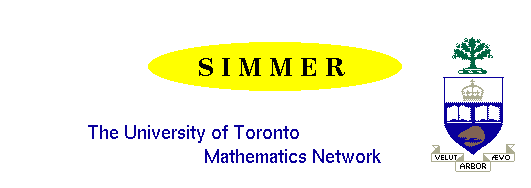

A MATHEMATICAL ‘HODGEPODGE’
presented by
Prof. Mark Spivakovsky (Mathematics, University of Toronto)
on Tuesday, November 23,
1999
6:00 - 9:00 p. m.
Every
professional mathematician is familiar with the following experience. You meet
someone at a party and they ask you what you do for a living. You reply
"mathematician" with some trepidation, for you already know the common
reaction: "I have always hated math and was never any good at it".
The
greatest challenge in my work as a teacher is trying to transmit my enthusiasm
for solving problems to my students. In this session I would like to share with
you some problems that might get people, young and old hooked on problem solving
with reasoning. Here are a few you can try your hand at:
Which is greater: 9950 + 10050 or
10150?
Prove that for every integer n>2, (n!)2
> nn
*********************************************
Here is a collection of problems discussed at the November 1999 SIMMER meeting
Problem 1. Which is greater: 9950 + 10050 or 10150 ?
Problem 2. (a) In how many ways can 8 rooks be placed on an 8 x 8 chessboard in such a way that no rook can take another?
(b) In how many ways can 4 rooks be placed on an 8 x 8 chessboard in such a way that no rook can take another?
Problem 3. Find the area of the region in the plane, bounded on the right
by the ellipse x2 + 3y2 = 3 and on the
left by the straight line x = ![]()
Hint: this problem can be solved without using integration.
Problem 4. Let X be a figure in the plane. Assume that X is moved to itself by a rotation about a point O by 48o. Does it necessarily follow that X is moved to itself by a rotation about O by 90o ? by 72o ?
Problem 5. Prove that for every integer n > 2, (1.2.….n)2 > nn.
Problem 6. Into how many parts is a plane divided by n straight lines, such that no two lines are parallel and no three lines pass through the same point?
Problem 7. Find the last three digits of the sum
11999 + 21999 + 31999 + 41999 + … + 9999981999 + 9999991999
Problem 8. The monetary unit in the Republic of Oz is called an emerald, and both three emerald and five emerald bills are in circulation. Prove that any sum greater than 7 emeralds can be paid by three and five emerald notes.
Problem 9. Suppose that a plane is divided into parts by n straight lines. Prove that these parts can be coloured with red and white paint, such that any two parts, having a common side, are coloured with different colours.
Problem 10. For a positive integer x with at least two digits, let F(x) denote the integer obtained from x by deleting the first digit. Does there exist x such that
a) x = 58.F(x) ? b) x = 57.F(x) ?
Problems to think about for
the November 1999 SIMMER meeting (same as
above, in PDF format)
Solutions to the first set if ten problems
(in PDF format)
Additional problems to think about, handed
out at the November 1999 SIMMER meeting (in PDF format)
You will need to have Acrobat Reader on your machine to enable you to read/print PDF files. The Acrobat Reader is free to download from Adobe Systems. If you have difficulty in getting these print outs, please contact MathNet to have copies mailed to you.
Back to the SIMMER home page
Back to the
U of T Mathematics Network
Home Page ![]() or Fields Institute Home Page
or Fields Institute Home Page
![]()
This page was last updated: October 29, 2000